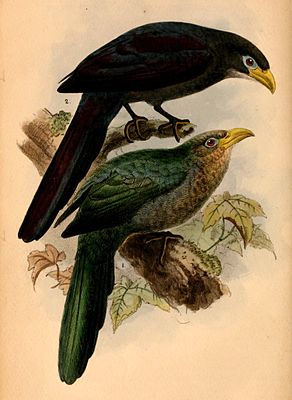Ore cuckoos
| Ore cuckoos | ||||||||||
|---|---|---|---|---|---|---|---|---|---|---|

Western cuckoo ( Ceuthmochares aereus ) behind; Easter cuckoo ( Ceuthmochares australis ) behind |
||||||||||
| Systematics | ||||||||||
|
||||||||||
| Scientific name | ||||||||||
| Ceuthmochares | ||||||||||
| Cabanis & Heine , 1863 |
The ore cuckoos ( Ceuthmochares ) are a genus from the family of the cuckoo birds, which belongs to the subfamily of the spotted cuckoo . Unlike many species of cuckoos, they are not brood parasites , but raise their offspring themselves.
Ore cuckoos are tree-dwelling cuckoos that only occur in the Afrotropic ecozone. For some years now, two species have been distinguished that belong to this genus. The Easter cuckoo was previously considered a subspecies of the western cuckoo . Both species are resident birds.
For both species the population situation is given as LC (= least concern - not endangered ), because their range is large and they are comparatively common birds in parts of this range.
features
Ore cuckoos reach a body length of about 33 centimeters. The control springs account for around 20 to 21 centimeters. The strong beak measures around 2.4 centimeters. They weigh between 60 and 70 grams.
There is no conspicuous sexual dimorphism in either species . The plumage is predominantly gray or dark green. The iris is red or chestnut brown, in young birds it is brown. Both species have a noticeable eyelid ring and the strong beak is bright yellow and turns black at the base of the beak. The legs are black.
The iris is red or chestnut brown, in young birds it is brown. The eyelid ring is yellow and turns green in front of the eye. The strong beak is bright yellow and turns black, especially at the base of the beak. The legs are black.
Young birds are similar to the adult birds, but are generally duller in color.
Distribution area
Ore cuckoos are species of the Afrotropic ecozone. The distribution area of the Easter cuckoo is the east of Africa. It extends from the southwest of Ethiopia, through the northeast of Uganda, the south of Somalia, the east of Kenya to Tanzania to the north and east of Zambia, Mozambique, Malawi, the south of Zimbabwe to the east of the Republic of South Africa. The Easter cuckoo is predominantly a resident bird. However, there are indications that this species of cuckoo leaves the coastal regions of Kenya and Tanzania and moves inland between October and April.
The distribution area of the western cuckoo is in the west of Africa and extends from the coast of Senegal , Gambia and Guinea to Uganda and in the south of Sudan , the west of Kenya and the north-west of Tanzania . It is also found in northern Angola , Gabon and Equatorial Guinea .
Way of life
Ore cuckoos are secretly living birds that usually hang out in the thick foliage of tree tops. They find their food mainly in treetops eight to 30 meters above the ground. They mainly eat caterpillars, including, like many other cuckoos, very hairy caterpillars, which are avoided by most other bird species. They also eat flying termites, beetles, bees, cockroaches, spiders, snails and tree frogs. Occasional feeding of smaller birds has also been proven for the western cuckoo. It also eats fruits, seeds and leaves.
Little is known about the reproduction of the ore cuckoo. It is assumed that both species are monogamous and defend a territory. The nest is a loose platform made of leafy branches, which is usually set up two to five meters above the ground in a fork of branches. The clutch usually consists of two eggs, in rare cases up to four eggs. They are white to cream in color. So far nothing is known about the development of the nestlings and young birds.
species
The following species are included in the genus:
- Western cuckoo ( Ceuthmochares aereus )
- Easter cuckoo ( Ceuthmochares australis )
The Easter cuckoo is monotypical .
literature
- Johannes Erhitzøe, Clive F. Mann, Frederik P. Brammer, Richard A. Fuller: Cuckoos of the World . Christopher Helm, London 2012, ISBN 978-0-7136-6034-0 .
Web links
Single receipts
- ↑ a b c d Erhitzøe, Mann, Brammer, Fuller: Cuckoos of the World . P. 233.
- ^ Robert B. Payne: The Cuckoos . Oxford University Press 2005. (Bird Families of the World No. 15) ISBN 0-19-850213-3 .
- ^ IUCN: Osterzkuckuck , accessed on August 17, 2016
- ↑ IUCN: Westerzkuckuck , accessed on August 20, 2016
- ↑ a b Erhitzøe, Mann, Brammer, Fuller: Cuckoos of the World . P. 233 and p. 235.
- ↑ a b Erhitzøe, Mann, Brammer, Fuller: Cuckoos of the World . P. 234 and p. 236.
- ↑ Erhitzøe, Mann, Brammer, Fuller: Cuckoos of the World . P. 236.